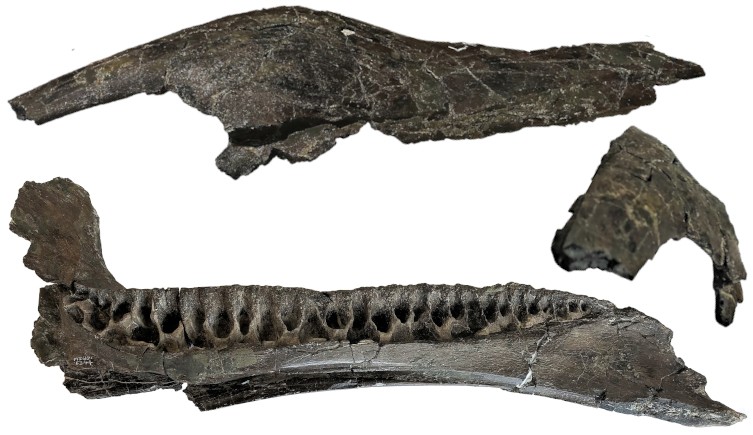Create a list of articles to read later. You will be able to access your list from any article in Discover.
You don't have any saved articles.

Brighstoneus simmondsi would have roamed during the Cretaceous period 125 million years ago. Image © John Sibbick
A new species of dinosaur has been discovered from the Isle of Wight after a case of mistaken identity.
The new dinosaur, now called Brighstoneus simmondsi, is a close relative of Iguanodon. The new species has more teeth, a curved nose and other features that are different to its more famous relation.
Researchers believe it could be the first of many new finds on the Isle of Wight, challenging the previous view that there were only two main species of iguanodontids on the island.
Jeremy Lockwood is a PhD student at the Museum and lead author of the article published in the Journal of Systematic Palaeontology.
He says that the find is part of a 'golden age' for British palaeontology, and follows two new spinosaurids from the island being described in September.
'It's exciting,' says Jeremy, who worked on the paper alongside Museum scientists to describe this new species. 'I think we've got a little gold mine here.
'British dinosaurs are certainly not something that's done and dusted at all. I think we are onto a new renaissance.'

The new dinosaur was discovered by Jeremy Lockwood (pictured) after looking through historic collections.
The new dinosaur is found in deposits from the early Cretaceous Period, from some 125 million years ago. These deposits are rare across the world, being found in Mongolia, China, some areas of Japan and the Isle of Wight.
'The land on the Isle of Wight is being eroded continuously by the sea, so there is a tremendous amount of material being produced,' Jeremy says. 'It's said to be the richest source of dinosaur bones in Europe.'
However, while many bones have been found on the island, Iguanodon-like bones have previously been thought to belong to just two species: Mantellisaurus atherfieldensis and the larger Iguanodon bernissartensis. Jeremy says that while working as a GP - even before he began his career in palaeontology - he had been 'a bit uncomfortable' with this.
'In medicine I did a lot of work in anatomy, and I was always struck by the fact that if you look at one human bone or another, they look exactly the same,' he says. 'People were telling me that the bones I was finding were all from the same animals, but they looked very different.'
'It's easy to distinguish those two species on size, so everything has tended to be pushed into one of them based on little more than that. The whole thing has almost been self-perpetuating.'
Having relocated to the Isle of Wight to study the finds in more detail, Jeremy attributes the lack of previous discoveries to the island's place in history, and geographically.
'The early Isle of Wight collection is all at the Museum, but in the last 40 years or so more of it has been kept on the island. Being an island, it's that little bit harder to get to, and perhaps historically that's probably stopped people coming and spending more time here,' he says.
'Also, as the island is tied in with the birth of dinosaurs, the fossil that pushed Richard Owen into naming the dinosaurs was from the island. I think there's a sort of feeling that as it's been 200 years, it's all been found by now.'

Brighstoneus simmondsi is set apart from its relatives by its bulbous nose and additional teeth.
Having set out to look through the Isle of Wight's collections, Jeremy came across a partial skeleton that didn't seem to fit with the species it was attributed to.
'I'd taken lots of photographs and so I tried to reconstruct the skull,' he says. 'I tried to put the nasal bone into its life position, and I couldn't believe what I found.
'I missed it the first time because it was a curved bone and it was lying flat, but in its life position it had a bulbous nose, whereas the other species have very straight noses, so that was what really made me think it was different.
'The number of teeth was also a sign. Mantellisaurus has 23 or 24, but this has 28, which is quite a lot more. It was also a long, thin dentary (the lower jawbone), the height of which is lower but longer than in Mantellisaurus. It would be really weird to get narrower as it ages, so it all seemed wrong.
'There were lots of other little things as well. Each difference couldn't have done it alone, but altogether it made it very obviously a new species to me.'
Jeremy believes that other Iguanodon-like species unknown to science may also have been incorrectly identified, which suggests a potential for many new dinosaurs. He is already looking at another skeleton that could be a new species.
'We're looking at six, maybe seven million years of deposits, and I think the genus lengths have been overestimated in the past,' he says. 'If that's the case on the island, we could be seeing many more new species.
'It seems so unlikely to just have two animals being exactly the same for millions of years without change.'
Jeremy's find also has the potential to lead to a wider change in how we understand this group of dinosaurs, which could lead to reassessments of finds across the whole of Europe.
'This discovery demonstrates, at least in England, that we can't just ascribe them all to Mantellisaurus,' Jeremy says. 'It's got to change.'